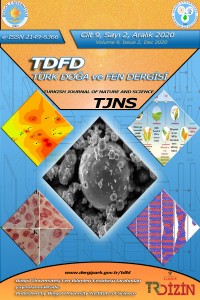Abstract
Genetiği değiştirilmiş organizmalar ve ürünleri artan dünya nüfusu ve gıda ihtiyacından dolayı son çeyrek asırda çağın teknolojik gelişmelerinin neticesinde geliştirilen rekombinant DNA teknolojileri kullanılarak elde edilmektedir. Çeşitli stres faktörlerine karşı etkin mücadelede başarılı sonuçlar elde edilmesine rağmen istenmeyen sonuçların açığa çıkmasına engel olunamamıştır. Bununla birlikte transgenik üretimler küresel olarak büyük bir ekim alanına ve ticaret hacmine ulaşmıştır. Bütün bu olumlu ve olumsuz düşünceler, bu ürünlere yönelik biyogüvenlik risklerini ve önlemlerini kapsayan kanuni uygulamaların yürürlüğe girmesine neden olmuştur. Bu kanunların uygulanmasının nedenleri bu tarz çalışmaları belli bir etik çerçeve içine almak, gıda güvenliği ve kalitesini sağlayarak insan sağlığı ve ekolojik olumsuzlukların önüne geçmektir. Biyogüvenlik kanunlarının yasal çerçeveleri oluşturulurken bilimsel ve teknolojik gelişmelerin yanı sıra bu ürünlerin avantaj, dezavantaj veya risklerinin açığa çıkarılması ile ilgili etkin bir kamuoyu algısı oluşturma dikkate alınmalıdır. Bu çalışmada genetik yapısı değiştirilmiş organizmalar ve ürünleri ilgili yapılan araştırma, geliştirme, piyasaya sürme, izleme, ithalat ve ihracatı gibi düzenlemeleri kapsayan biyogüvenlik risklerinin değerlendirilmesi, yönetilmesi ve iletişimi tartışılmaktadır.
Keywords
References
- [1] Folta K. What is a GMO? 2018 [Available from: https://gmoanswers.com/what-gmo [Erişim tarihi: 06.07.2020].
- [2] Schütte G, Eckerstorfer M, Rastelli V, Reichenbecher W, Restrepo-Vassalli S, Ruohonen-Lehto M, et al. Herbicide resistance and biodiversity: agronomic and environmental aspects of genetically modified herbicide-resistant plants. Environmental Sciences Europe. 2017;29(1):5.
- [3] Tappeser B, Reichenbecher W, Teichmann H. Agronomic and environmental aspects of the cultivation of genetically modified herbicide-resistant plants. A joint paper of BfN (Germany), FOEN (Switzerland) and EAA (Austria). BfN-Skripten (Bundesamt für Naturschutz). 2014(362).
- [4] Rangel G. GMOs SEo, editor. Harvard University2015. [cited 2019]. Available from: http://sitn.hms.harvard.edu/flash/2015/from-corgis-to-corn-a-brief-look-at-the-long- history-of-gmo-technology/.
- [5] Kaya Y, Yilmaz S, Marakli S, Gozukirmizi N, Huyop F. Transformation of Nicotiana tabacum with dehE gene. Journal of Food Agriculture and Environment. 2013;11(3-4).
- [6] Kaya Y, Marakli S, Gozikirmizi N, Mohamed E, Javed M, Huyop F. Herbicide tolerance genes derived from bacteria. The Journal of Animal and Plant Sciences. 2013;23(1):85-91.
- [7] Aksoy HM, Kaya Y, Tengku Abdul Hamid TH. Expression of the dspA/E gene of Erwinia amylovora in non-host plant Arabidopsis thaliana. Biotechnology & Biotechnological Equipment. 2017;31(1):85-90.
- [8] ISAAA. Global Status of Commercialized Biotech/GM Crops in 2017: Biotech Crop Adoption Surges as Economic Benefits Accumulate in 22 Years. . Ithaca, NY. : The International Service for the Acquisition of Agri-biotech Applications (ISAAA). 2017.
- [9] ISAAA. GM Aproval Database 2018 [Available from: http://www.isaaa.org/gmapprovaldatabase/default.asp [Erişim Tarihi: 22.10.2020].
- [10] James C. Gobal status of commercialized biotech/GM crops 2018 [Available from: http://www.isaaa.org/default.asp [Erişim Tarihi: 06.07.2020].
- [11] Arvas YE. Genetiği Değiştirilmiş Bitkiler ve Tanısı: LAP Lambert Academic Publishing; 2017.
- [12] Haspolat I. Genetiği değiştirilmiş organizmalar ve biyogüvenlik. Ankara Üniv Vet Fak Derg. 2012;59:75-80.
- [13] Arvas YE, Kaya Y. Genetiği Değiştirilmiş Bitkilerin Biyolojik Çeşitliliğe Potansiyel Etkileri. Yüzüncü Yıl Üniversitesi Tarım Bilimleri Dergisi. 2019;29(1):168-77.
- [14] Ansari MuR, Shaheen T, Bukhari S, Husnain T. Genetic improvement of rice for biotic and abiotic stress tolerance. Turkish Journal of Botany. 2015;39(6):911-9.
- [15] Messeguer J, Marfa V, Catala M, Guiderdoni E, Melé E. A field study of pollen- mediated gene flow from Mediterranean GM rice to conventional rice and the red rice weed. Molecular Breeding. 2004;13(1):103-12.
- [16] Zhang JZ, Creelman RA, Zhu J-K. From laboratory to field. Using information from Arabidopsis to engineer salt, cold, and drought tolerance in crops. Plant physiology. 2004;135(2):615-21.
- [17] Wang Y, Li Y, Romeis J, Chen X, Zhang J, Chen H, et al. Consumption of Bt rice pollen expressing Cry2Aa does not cause adverse effects on adult Chrysoperla sinica Tjeder (Neuroptera: Chrysopidae). Biological Control. 2012;61(3):246-51.
- [18] Wang Y, Zhang L, Li Y, Liu Y, Han L, Zhu Z, et al. Expression of Cry1Ab protein in a marker-free transgenic Bt rice line and its efficacy in controlling a target pest, Chilo suppressalis (Lepidoptera: Crambidae). Environmental entomology. 2014;43(2):528- 36.
- [19] Rahman M, Zaman M, Shaheen T, Irem S, Zafar Y. Safe use of Cry genes in genetically modified crops. Environmental chemistry letters. 2015;13(3):239-49.
- [20] Tu J, Datta K, Khush G, Zhang Q, Datta S. Field performance of Xa21 transgenic indica rice (Oryza sativa L.), IR72. TAG Theoretical and Applied Genetics. 2000;101(1):15-20.
- [21] Tu J, Zhang G, Datta K, Xu C, He Y, Zhang Q, et al. Field performance of transgenic elite commercial hybrid rice expressing Bacillus thuringiensis δ-endotoxin. Nature biotechnology. 2000;18(10):1101-4.
- [22] Rai A, Singh A, Syiem M. Plant Growth-Promoting Abilities in Cyanobacteria. Cyanobacteria: Elsevier; 2019. p. 459-76.
- [23] Mukhtar Z, Hasnain S. Transgenic basmati rice transformed with the Xa21 gene shows resistance against bacterial leaf blight. Turkish Journal of Botany. 2017;41(1):1-10.
- [24] Jung S, Chung JS, Chon S-U, Kuk YI, Lee HJ, Guh JO, et al. Expression of recombinant protoporphyrinogen oxidase influences growth and morphological characteristics in transgenic rice. Plant growth regulation. 2004;42(3):283-8.
- [25] Hur J, Jung K-H, Lee C-H, An G. Stress-inducible OsP5CS2 gene is essential for salt and cold tolerance in rice. Plant Science. 2004;167(3):417-26.
Details
| Primary Language | Turkish |
|---|---|
| Subjects | Agricultural, Veterinary and Food Sciences |
| Journal Section | Review |
| Authors | |
| Publication Date | December 30, 2020 |
| Published in Issue | Year 2020 Volume: 9 Issue: 2 |
Cite
Cited By
Sentetik Tohum
Frontiers in Life Sciences and Related Technologies
https://doi.org/10.51753/flsrt.943981
Dünya Pamuk Tarımı ve Ekonomiye Katkısı
MANAS Sosyal Araştırmalar Dergisi
https://doi.org/10.33206/mjss.858702
Modern agriculture and challenges
Frontiers in Life Sciences and Related Technologies
https://doi.org/10.51753/flsrt.856349
Bazı Ketencik Genotiplerinde Farklı Tuzluluk Seviyelerinin Agronomik Özelliklere Etkisi
Manas Journal of Agriculture Veterinary and Life Sciences
https://doi.org/10.53518/mjavl.1343969
Comparison of DNA isolation methods for GMO detection from biscuit samples
Anatolian Journal of Botany
https://doi.org/10.30616/ajb.1527481
This work is licensed under the Creative Commons Attribution-Non-Commercial-Non-Derivable 4.0 International License.

